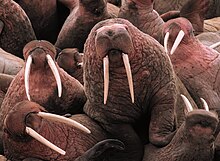Otarioidea
| Otarioidea | |
|---|---|

| |
| A rookery of walruses (Odobenus rosmarus) | |

| |
| A male and female South American sea lion (Otaria flavescens) | |
| Scientific classification | |
| Domain: | Eukaryota |
| Kingdom: | Animalia |
| Phylum: | Chordata |
| Class: | Mammalia |
| Order: | Carnivora |
| Clade: | Pinnipedia |
| Superfamily: | Otarioidea J. E. Gray, 1821 |
| Subclades | |
| |
Otarioidea is a superfamily of pinnipeds that includes the families Odobenidae, Otariidae and their stem-relatives.[1][2] In the past when the pinnipeds were considered to be a diphyletic group of marine mammals, a few points of cranial and dental morphology suggested that the otarioids originated from a line of bears.[3] One extinct family, Enaliarctidae, was postulated to be otarioids that were a transitional clade between Hemicyoninae (an extinct subfamily of dog-like bears) and Otariidae.[3] Recent comprehensive studies have, however, since the 1990s found pinnipeds to be a monophyletic clade of aquatic arctoids.[1] There are a few authorities that place desmatophocids and odobenids as sister taxa to Phocidae in the clade Phocomorpha based on a few minor physiological features.[4]
References
[edit]- ^ a b Berta, A.; Churchill, M. & Boessenecker, R.W. (2018). "The Origin and Evolutionary Biology of Pinnipeds: Seals, Sea Lions, and Walruses". Annual Review of Earth and Planetary Sciences. 46: 203–228. Bibcode:2018AREPS..46..203B. doi:10.1146/annurev-earth-082517-010009.
- ^ Paterson, R. S.; Rybczynski, N.; Kohno, N.; Maddin, H. C. (2020). "A Total Evidence Phylogenetic Analysis of Pinniped Phylogeny and the Possibility of Parallel Evolution Within a Monophyletic Framework". Frontiers in Ecology and Evolution. 7 (457). doi:10.3389/fevo.2019.00457.
- ^ a b Mitchell, E. & Tedford, R. H. (1973). "The Enaliarctinae: a new group of extinct aquatic Carnivora and a consideration of the origin of the Otariidae". Bulletin of the AMNH. 151 (3). hdl:2246/1178.
- ^ McKenna, Malcolm C., and Susan K. Bell (1997). Classification of Mammals Above the Species Level. New York: Columbia University Press. 631 pp. ISBN 0-231-11013-8




